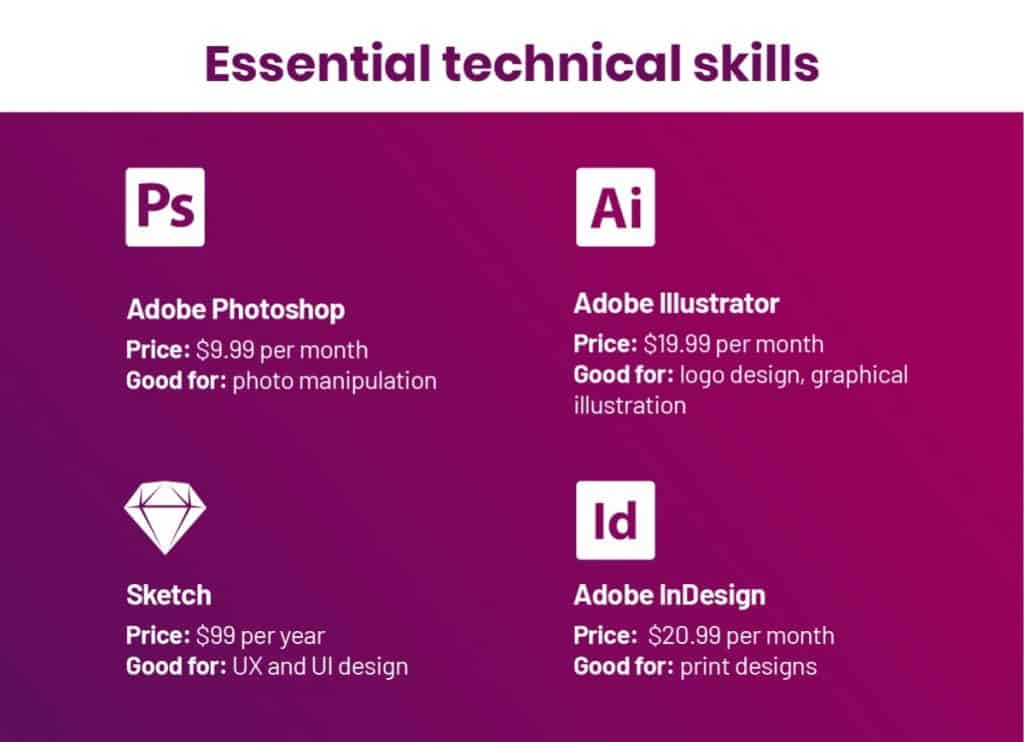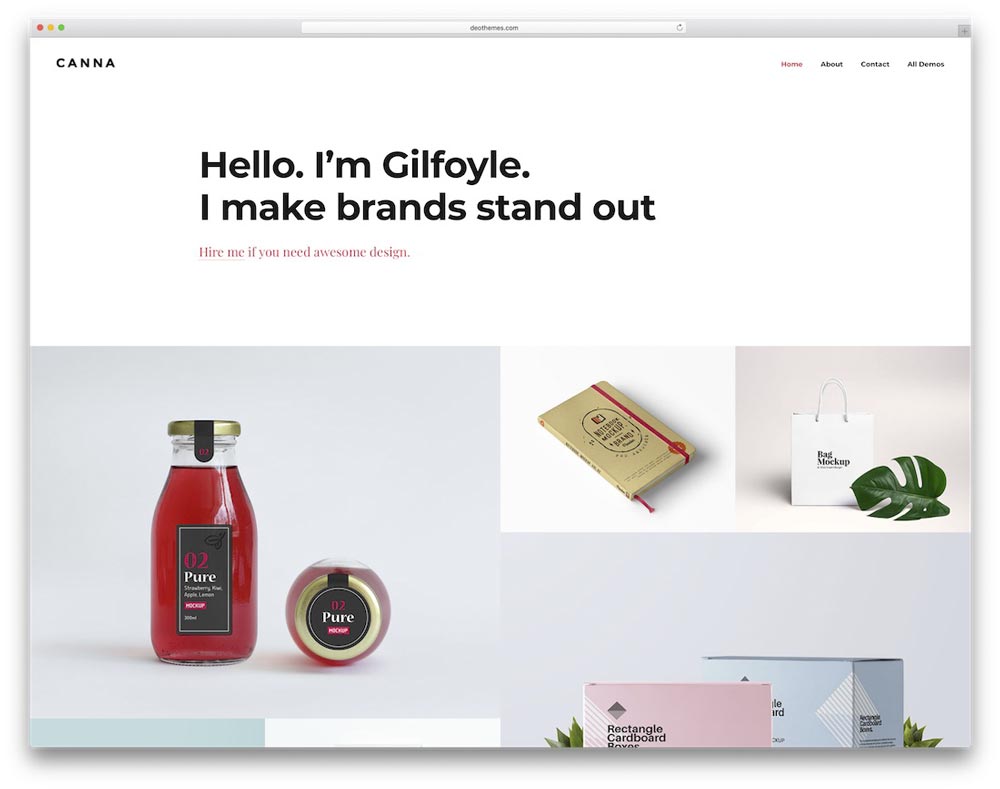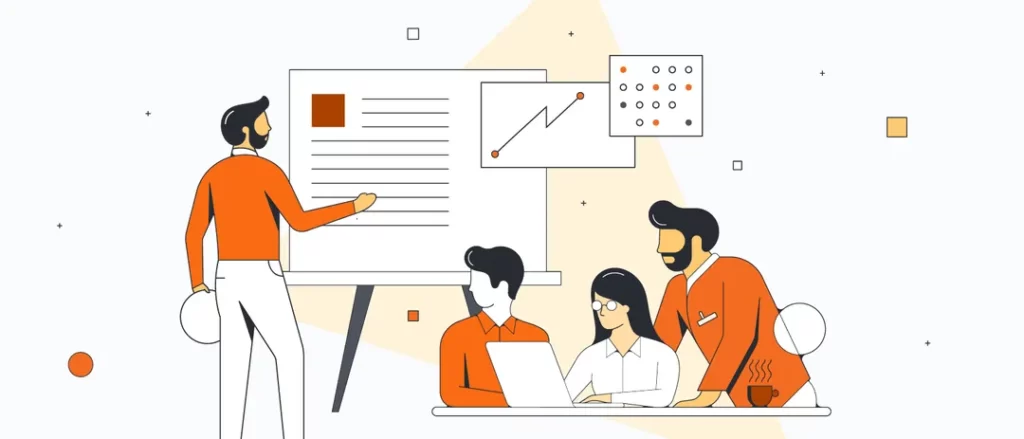Boost Your Design Skill: The Complete Guide for Aspiring Designers
Nowadays, design skills are more in demand than ever. Whether you're looking to launch a career in graphic design, web design, UI/UX design, or any other creative field, honing your design abilities can open up a world of exciting opportunities. But where do you start when you want to boost your design skill?
This comprehensive guide covers everything you need to know to become a standout designer. Follow these tips to level up your design game and make yourself irresistible to potential employers or clients.
Table of Contents
Learn the Fundamentals

Before you can run, you have to walk. Building a solid foundation in visual communication and aesthetics principles is essential when starting design. Mastering the basics lets you create pleasing, functional designs and communicate ideas effectively.
Here are some of the core design fundamentals every aspiring designer should study:
Colour Theory
Understanding how colours interact, complement each other, and evoke emotions allows you to use colour purposefully in your designs. Studying basic colour theory helps you combine appealing hues with your creative goals.
Typography
Typography is central to design work. Learning best practices for choosing fonts, arranging type, and using type stylistically improves your designs. Typography can significantly impact the tone and clarity of your visual messaging.
Layout/Composition
Layout refers to how you arrange and structure elements within a design. Mastering composition allows you to guide the viewer's eye and create a visual hierarchy. Well-composed layouts are aesthetically pleasing and enhance usability.
Visual Hierarchy
This principle involves using a varying scale, colour, placement, and contrast to indicate the level of importance of each element in a design. Proper visual hierarchy ensures that viewers focus on the most critical parts first.
Design Principles
Principles like balance, contrast, emphasis, repetition, proximity, white space, and more allow you to organise information logically and make designs visually appealing. Learning how to apply these principles creates polished work.
Branding Fundamentals
Designers must understand brand identity and how to express brand personality visually: study colour psychology, messaging, logo design, and more to master branding basics.
Mastering the foundations before moving to specialised skills ensures you have the core abilities to create quality designs in any medium.
Develop Your Creativity
Raw talent only gets you so far in design. You must nurture and develop your creativity through continuous practice to truly excel. Here are some ways to expand your creative abilities:
- Try design exercises and challenges. Assign yourself daily or weekly design challenges that flex your skills in new ways.
- Step outside your comfort zone. Experiment with new styles, techniques, and mediums that push you creatively. Don't be afraid to fail as you try new things.
- Draw inspiration from others. Study designs you admire and analyse what makes them effective. Let the work of talented designers motivate your creativity.
- Maintain a swipe file. Save designs, colour palettes, textures, fonts, and other visual elements that inspire you in an organised swipe file you can reference.
- Feed your curiosity. Read design blogs and books, listen to creative podcasts, follow industry leaders on social media, visit museums, and more to stay inspired.
- Sketch and iterate. Quickly sketching ideas and variations boost your ideation abilities. Refine concepts through continual iteration.
- Collaborate and share. Discussing ideas and collaborating on designs exposes you to new perspectives.
- Reflect on your work. Identify what you did well and what you could improve to get better with each new project.
Creativity takes continual nurturing. But making it a daily habit results in endless inventive design solutions.
Develop Technical Proficiency

While creativity is crucial, you need the technical know-how to execute your ideas expertly. Mastering design software and best practices for your speciality is a must.
For graphic design, become an expert in programs like Adobe Photoshop, Illustrator, and InDesign. Web designers need fluency in HTML, CSS, JavaScript, and content management systems like WordPress. UX/UI designers should master tools like Sketch, Figma, and Adobe XD.
Aspiring designers should:
- Take online courses to build technical skills in relevant software/languages.
- Use programs daily to get comfortable with all the features. Replicate designs from Dribbble, Behance, etc.
- Read manuals, books, and design blogs to learn best practices.
- Experiment and test capabilities to push your technical abilities. Don't just stick to what you already know.
- Download practice files to work through exercises and tutorials.
- Watch video tutorials by design experts to see techniques in action.
- Get training and certificates to validate technical proficiency.
- Practice, practice, practice! There are no shortcuts for completing the hours needed to master design software.
The supreme technical ability allows you to bring your creative visions to life effortlessly. Develop these skills in tandem with your creative capacities.
Understand User Psychology
Now more than ever, designers must consider how users interact with their work. Gaining insight into user psychology allows you to craft designs that resonate with people and influence behaviour.
Key Areas to Study:
- User cognition: How people process information and make decisions.
- Human-computer interaction: How users interact with digital interfaces and content.
- Visual perception: How people interpret and extract meaning from visuals.
- Behavioural design/UX psychology: Applying psychology principles to influence user behaviour and emotions through design.
- Accessibility and inclusive design: Designing for people with disabilities and diverse needs.
- Persuasive design: Using various techniques to convince users to take desired actions.
- Emotional design: Design that generates positive emotions and emotional connections.
Understanding factors like visual hierarchy, cognitive load, biases, and emotional design gives you the power to design effectively for the human brain. Use that knowledge to boost engagement and conversion rates.
Develop a Design Specialty
Generalist designers have value, but specialising makes you stand out. Develop expertise in an in-demand design field like:
- Graphic design – Print, marketing, branding, packaging, advertising, etc.
- Web/digital design – Websites, landing pages, e-commerce, mobile apps, banners, emails, etc.
- UI/UX design – Crafting user interfaces and optimising user experience.
- Illustration – Digital or traditional illustration across styles and mediums.
- Motion graphics – Animated visual content like videos, GIFs, and ads.
- Design for AR/VR – Immersive augmented and virtual reality experiences.
- Environmental design – Physical spaces like retail, office, hospitality, etc.
- Industrial design – Product design, furniture, automotive, etc.
- Design research – Qualitative user studies to guide design decisions.
Choose an area aligned with your strengths and interests, then gain expertise through specialised courses, reading, freelance gigs, etc. Having a design focus makes you a go-to resource.
Build a Stellar Portfolio

Your portfolio is the best representation of your skills and style. Invest time into curating an impressive portfolio that demonstrates your capabilities and lands you clients or jobs.
Portfolio Tips:
- Showcase 8-15 diverse pieces that reflect your speciality. Quality over quantity.
- Lead with your best work to grab attention fast.
- Include detailed project descriptions explaining the design objective, process, and results.
- Optimise images for fast loading and visual impact at first glance.
- Make it skimmable with plenty of visual interest over dense text.
- Showcase process and iterations to demonstrate your working methods.
- Balance client work and passion projects to show professional practice and personal style.
- Link case studies with more in-depth information on select projects.
- Update frequently as you complete new, high-calibre work.
- Get feedback from designers to improve before going public.
- Choose a clean, mobile-friendly portfolio platform. Squarespace, Behance, and Wix have great options.
An impressive portfolio is your ticket to landing excellent design jobs and clients. Dedicate time to perfecting it.
Stay Current on Design Trends
Design is constantly evolving. Staying aware of emerging styles, techniques, and technology allows you to create cutting-edge work.
Ways to Stay Current:
- Read top design blogs like Smashing Magazine, AIGA Eye on Design, Creative Bloq, and more.
- Follow influential designers on Twitter and Instagram.
- Listen to design podcasts like Design Matters with Debbie Millman.
- Browse sites like Awwwards and Dribbble to see trending styles.
- Check out galleries of award-winning designs for inspiration.
- Attend local design networking events and conferences when possible.
- Experiment with new software features and 3D/animation tools as they emerge.
- Subscribe to online learning platforms like Skillshare and LinkedIn Learning for trending topics.
- Google and YouTube search trending terms like “design trends 2024” regularly.
- Step outside the design bubble occasionally for fresh inspiration.
Staying on the pulse of the design world allows you to meet demands and wow clients with innovative work. Stay caught up on the latest knowledge.
Polish Your Design Process
Having an optimised creative process allows you to work smarter, not harder. Refine your methodology to design efficiently and effectively.
Key Areas to Address:
- Research/competitive analysis – Gather insights to guide your work.
- Ideation techniques – Brainstorming, mind mapping, sketching methods, etc.
- Mood boards – Collect visual inspiration before you design.
- Style tiles – Explore stylistic directions before completing mockups.
- Prototyping – Test ideas before high-fidelity designs.
- Workflow – Find shortcuts and tools for efficiency.
- Feedback integration – Gather and implement feedback.
- Iteration mindset – Willingness to try options and refine constantly.
Having go-to frameworks ensures you save time in the design process. Analyse your methods, then optimise. Strike the ideal balance of structure and creative freedom.
Boost Your Business Savvy

Mastering the business side is crucial for designers. Learn skills like:
- Client/project management – Communication, expectations, timelines, etc.
- Contracts and legal issues – Protect yourself with good agreements.
- Marketing/networking – Promote your services effectively.
- Pricing/negotiation – Know your value and get fair compensation.
- Bookkeeping – Track expenses, invoices, taxes, etc.
- Time/schedule management – Balance multiple projects and priorities.
- Productivity hacks – Streamline your workflow.
- Business operations – Tools, systems, and processes to run efficiently.
- Personal branding – Build visibility and credibility.
Handling the business components with the same skill as the creative work makes you a competent, professional designer ready for real-world success.
Commit to Continuous Learning
In the fast-paced creative field, staying static means falling behind. Make lifelong learning and growth a priority through:
- Daily practice – Work on passion projects between client work.
- Online learning – Take courses, tutorials, and boot camps.
- Conferences/events – Attend local and national design events.
- Peer feedback – Join designer communities to exchange critiques.
- Reading – Books, blogs, and magazines for fresh knowledge.
- Freelance gigs – Gain experience with real-world projects.
- Apprenticeships/internships – Learn from design veterans.
- Certification – Earn credentials through examinations.
- Teaching/mentoring – You consolidate knowledge further when you teach others.
- Job shadowing – Observe professionals on the job.
- Side projects – Experiment with personal projects that test your skills.
The design field evolves rapidly. Commit to being a lifelong student through continuous education.
Key Takeaways for Developing Your Design Skills:
- Master design fundamentals like colour theory, typography, layout, visual hierarchy, and principles.
- Nurture your creativity through exercises, experimentation, and studying others' work.
- Develop technical proficiency with essential design software and tools.
- Understand user psychology and design thinking concepts.
- Specialise in an in-demand design field like UI/UX, web design, etc.
- Build an impressive, updated portfolio to showcase your best work.
- Stay current on the latest styles, techniques, and trends.
- Refine your design process for efficiency.
- Develop business savvy through marketing, pricing, project management, etc.
- Commit to lifelong learning and growth.
With consistent practice and dedication to building your skills, you can become a standout designer and thrive creatively and financially. Use this guide to help boost your design abilities at every stage of your journey. The design world is wide open for talented, hardworking professionals.
Frequently Asked Questions About Improving Design Skills
Still, have questions about ramping up your design skills? Check out answers to these common FAQs:
How long does it take to become a skilled designer?
It depends on factors like your innate creativity, your chosen speciality, and how intensely you study. However, expect 2-4 years of dedicated practice to become job/client-ready. Be patient and focus on continual growth.
What should beginners focus on when starting in design?
Start by studying design fundamentals, practising basic software skills, and absorbing as much knowledge as possible before specialised skills—experiment across disciplines to find your speciality.
What jobs can you get as an aspiring designer?
Junior design roles, internships, freelance/contract work, and apprenticeships allow you to gain experience before full-time creative positions. Build a portfolio before seeking senior roles.
Should you go to design school or self-study?
Both paths can work. Formal education provides structure, while self-study offers flexibility. Many successful designers are self-taught with intense drive.
What soft skills do designers need?
Communication, collaboration, critical thinking, time management, business/marketing skills, resilience, growth mindset, leadership, and passion for design are all essential.
How significant is a design degree versus a strong portfolio?
While a degree helps, the quality of your portfolio is most important for landing jobs. Some prioritise portfolios and experience entirely over degrees.
What should you include in a design portfolio?
Include 8-15 projects showcasing technical skill, creative style, and design process. Feature work relevant to your speciality and role goals.
How can you stay creative over the long term?
Make inspiration gathering and daily creation a habit. Collaborate, get feedback, stay curious, and continually push yourself into unfamiliar creative territory.
What is most rewarding about being a designer?
Many designers find seeing their creative visions come to life incredibly rewarding. Solving problems through design and seeing positive user reactions can also be gratifying.
Conclusion
Elevating your skills opens the door to a fantastic design career. With this comprehensive guide, you have a roadmap to build expertise in technical skills, creative thinking, design processes, business operations, and more.
Remember that continuous learning and improvement will serve you well in this fast-paced, ever-evolving field. Stay driven, keep your skills fresh, and lean on other talented designers to bring out your best work.
Soon, you'll have the expertise to bring your design visions to life. Just stick to the tips in this guide to develop sought-after skills, polish a fantastic portfolio, and become an in-demand designer!
